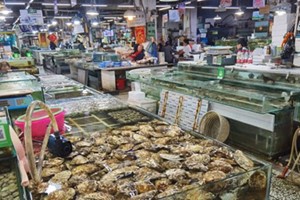North Korea's trade with China has recovered to 90% of pre-pandemic levels this year by staying under the radar of United Nations sanctions, as a walk through this border city shows.
A Chinese man in his 50s who runs a trading house here said he was recently approached by an executive from a North Korean company asking him to buy North Korean wigs.
Pyongyang "is desperate to earn foreign currency after flows plunged during the COVID crisis," the trader told Nikkei.
According to trade sources, state-run North Korean enterprises follow a contract manufacturing model for wigs. Hair and other materials are imported from China and shipped to the three main production hubs of Sinuiju, Rason and Pyongyang. Residents in nearby rural areas, working in their homes, weave the hair into nets, and the finished products are sent back to China for sale.
Each wig takes four to five hours to make. The North's low labor costs make the business viable, according to the sources.
Trade between the two neighbors -- which accounts for over 90% of North Korea's total trade -- came to $684.6 million for the first four months of this year, more than double the figure a year earlier and 91% of the same period in 2019, according to Chinese customs data. North Korean exports to China have exceeded 2019 levels.
Hair products such as wigs and false eyelashes was North Korea's top export to China, making up about half its total at $40.57 million.
"There was a lot of smuggling before, but North Korean authorities started allowing official exports this year, so trade is on the rise," the trader said.
The tougher sanctions imposed by the U.N. Security Council in 2017 banned the export of some of Pyongyang's biggest moneymakers, like coal, iron, seafood and textiles. But light industry, such as making wigs and clocks, remains outside their scope.
The North locked down its border in January 2020 as COVID-19 swept through China, blocking travel in or out of the country. Shipments by truck, ship and rail were all but halted starting that October, sending trade plummeting. Maritime shipping has since resumed, and freight train service between Dandong and Sinuiju restarted in September last year.
"The number of trains running is up in 2023 compared with 2022," the trader said.
Signs of sanctions violations can be found in Dandong. An employee at a seafood market here pointed out a water tank containing North Korean crabs and shellfish. Trade in seafood is still barred by the sanctions, but Chinese and North Korean ships reportedly transfer cargoes at sea to evade them.
Workers from the North are also still being sent to China in defiance of the sanctions. About 70,000 to 80,000 North Koreans are thought to live in Dandong, working in places like garment factories and seafood processing plants.
"Of their monthly pay of around 2,500 yuan ($350) each, the workers themselves get 600 to 800 yuan or so. North Korean authorities take most of the rest," said a manager at a factory employing North Korean workers.
The North's top import from China for the four months through April was rice, at $39.87 million, the customs data shows. Pyongyang is scrambling to ramp up imports from its neighbor again as it grapples with severe food shortages. North Korea produced 4.51 million tonnes of agricultural products last year, according to South Korea's Rural Development Administration, down about 180,000 tonnes from 2021 due partly to typhoon damage.
Shin Watanabe











